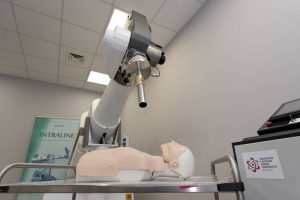NCBJ has presented an innovative medical accelerator
2017.03.29 8:53 - adminMalignant cells that might be left over in patient’s body after surgery of a tumour may be effectively destroyed just during the surgery. IntraLine, a new electron accelerator dedicated to such intra-operative treatment, was presented to oncology physicians who attended a conference organized in NCBJ Świerk on the occasion of conclusion of the INTRA-DOSE project.
Cancer is the second most common cause of death in EU countries just after circulatory diseases. Radiotherapy has always been among recognized methods of cancer treatment. Particular interest has recently been attracted by the technique of intra-operative irradiation of cavities after excised tumours. NCBJ jointly with Wielkopolskie Oncology Centre (WCO Poznań) presented IntraLine, a new electron accelerator dedicated to such intra-operative treatment on a conference organized in Świerk on the occasion of conclusion of the INTRA-DOSE project.
Several oncology physicians and medical physicists from various Polish oncology centres attended the two-day conference. Two sessions were held during the first conference day; speakers from NCBJ talked about the INTRA-DOSE project and on some interesting aspects of the IntraLine accelerator construction, while WCO experts discussed medical aspects of the intra-operative treatment. Accelerator prototype ready to clinical tests was for the first time presented to physicians. The Intra-operative therapy – a modern tool to treat cancer seminar was organized during the second conference day. Attendees could familiarize themselves with the process of getting ready the accelerator to specific runs and possible course of actions during various runs.
The technique to irradiate after-tumour cavities with electrons still during the surgery, referred to as intra-operative irradiation treatment, is among the most modern methods to tackle malignant cancers. Intra-operative accelerators are capable to deliver therapeutic beams to the lesion area easily, quickly and accurately. Physicians can more easily carry out the procedure, irradiation adverse side effects for patients can be minimized – pointed out Professor Julian Malicki, Director of WCO.
Numerous methods and tools used by modern medicine to kill malignant cancer cells include irradiation with various types of ionizing radiation (high-energy photons, electrons, protons, heavy ions). Such radiation is capable to damage cell DNA and dissociate water molecules into free radicals capable in turn to oxidize molecules used by cells to sustain biological processes. Unfortunately, photons interact not only with malignant cells within a tumour, but also with healthy tissue cells in front of and behind the tumour. On the other hand protons/heavy ions deposit their energy within a much more localized region so the interaction region may be accurately matched to the depth at which the tumour is localized. However, proton/heavy ion accelerators are rather large and expensive machines.
Electron irradiation technique combines advantages of photon irradiation and irradiation with massive charged particles. Accelerators capable to generate therapeutic beams of electrons are relatively inexpensive machines. Because of their relatively small size they can easily fit any operation room environment. In consequence, the beam may be delivered directly to after-tumour cavity exposed during the surgery, which significantly reduces the risk of damaging healthy tissues in front of the tumour. Adjusting proper energy of the electrons within the beam, the physicians may very precisely select the depth to which electrons will penetrate patient’s body, that way protecting healthy tissues behind the irradiated region. The main benefit of the technique is a significant reduction of the number of necessary after-surgery irradiation sessions i.e. reduction of the risk of adverse side effects.
The main features favourably distinguishing our accelerator over other similar devices on the market include high manoeuvrability of the entire machine/its head, high quality of the electron beam, and low level of stray radiation. Some devices on the market feature one or two of the above advantages, but to combine all three in a single, relatively small machine was quite a challenge – said Eng. Jacek Pracz from NCBJ – Several innovative technical solutions have been implemented in the IntraLine accelerator; they regard body construction, head positioning system, and construction of the beam forming head. Four of them have been patented.
The IntraLine accelerator has been developed with the framework of the INTRA-DOSE project realized by a consortium composed of NCBJ Świerk, WCO Poznań, UJP Hitec Systems S.A., and the Jarosław Kołcun company. The first R&D works on machines for intra-operative cancer therapy started already in 2008 within the framework of the Accelerators and Detectors project concluded in 2014 with a demonstrator of the device. The currently presented Minimum Viable Product (fully operational accelerator) has been developed by a team of over 50 physicists, engineers and oncologists.
We hope that multi-year efforts of the team will soon materialize as concrete help for sick people. The just developed mobile accelerator for intra-operative radiation therapy will now be moved to Wielkopolskie Oncology Centre, where its clinical tests will commence – said Dr. Agnieszka Syntfeld-Każuch (NCBJ).
The INTRA-DOSE project was supported by National Centre for Research & Development within the framework of the Basic Applied Research programme, path B.

















